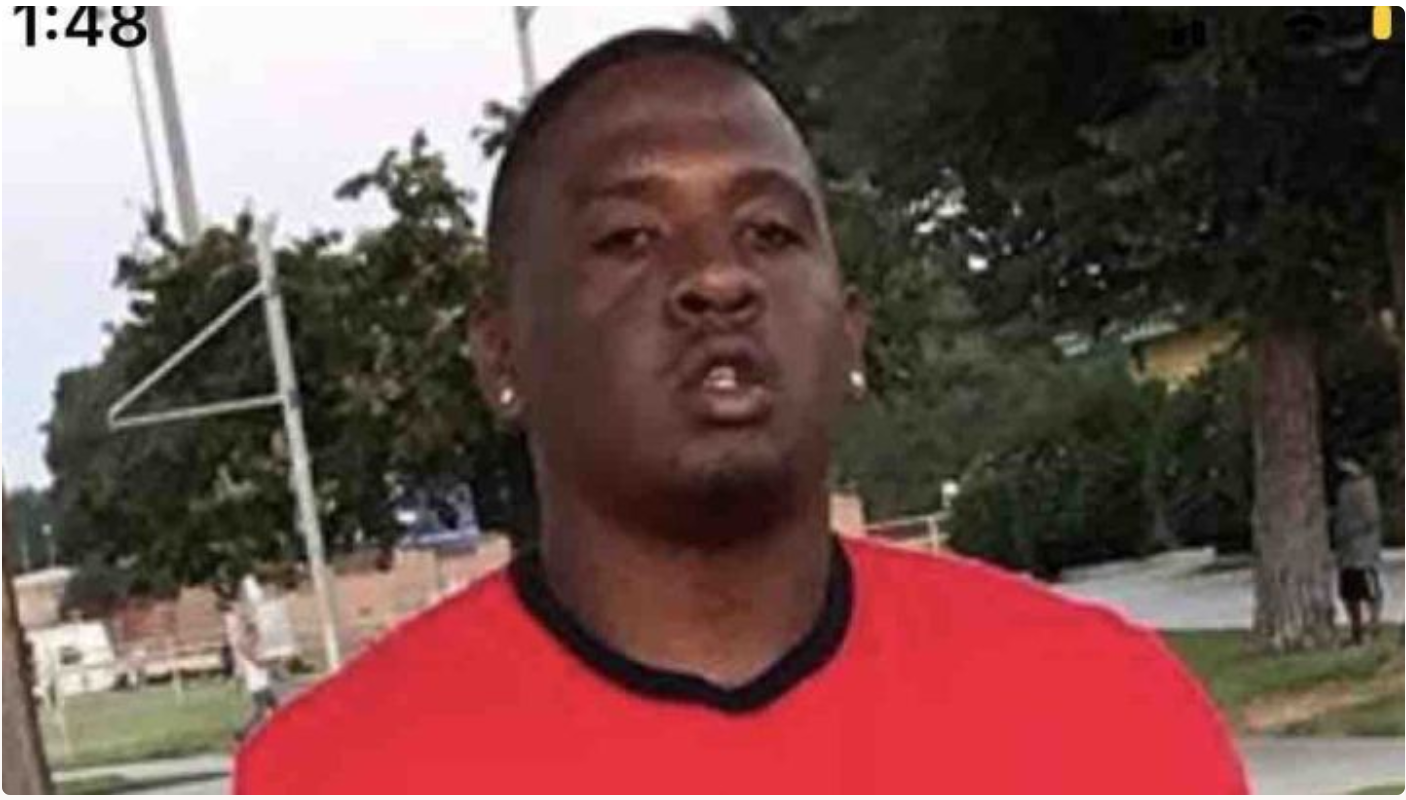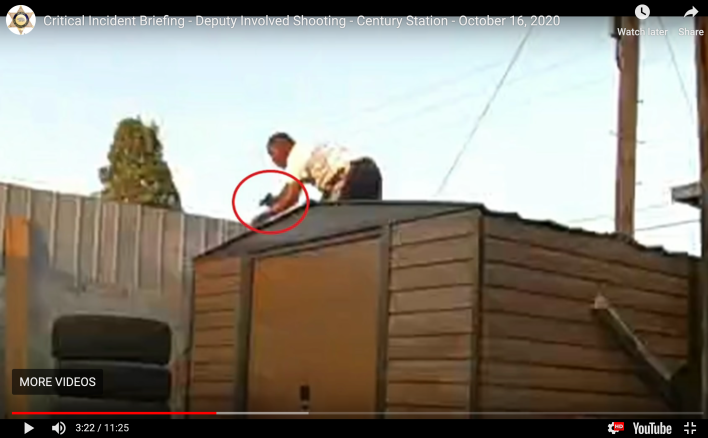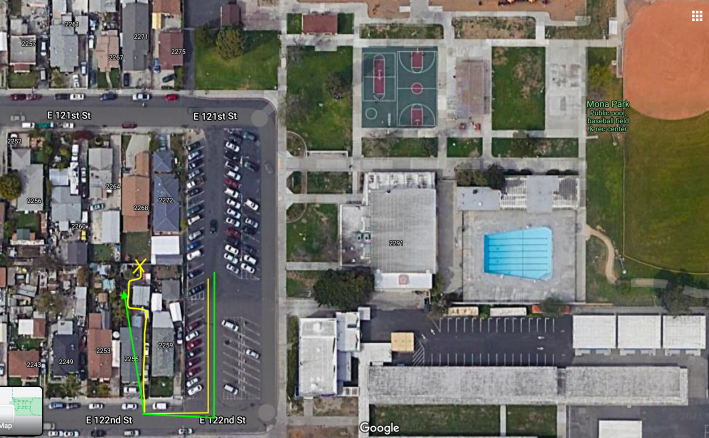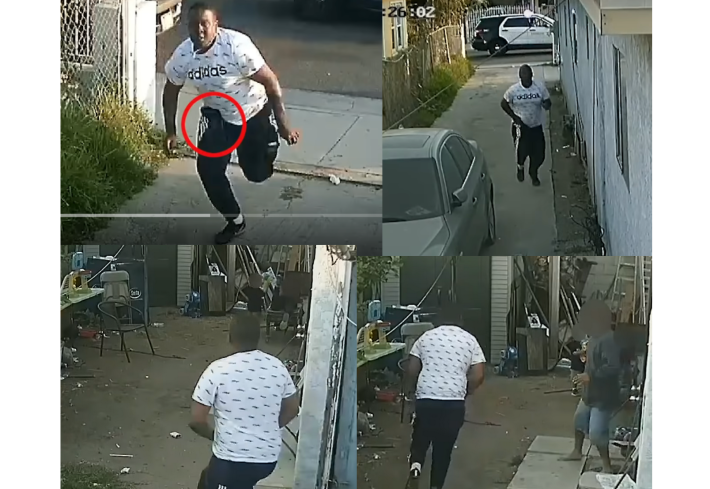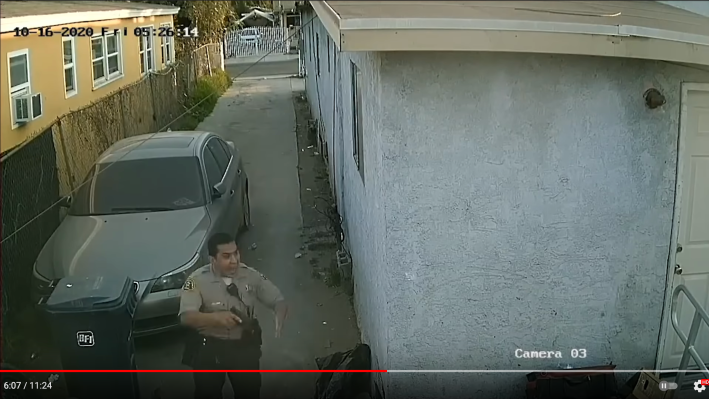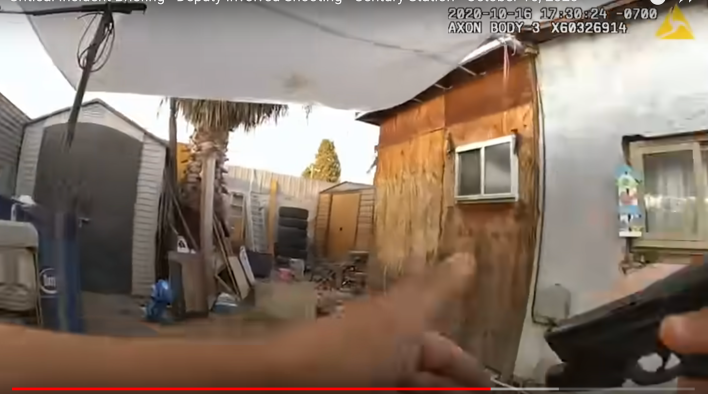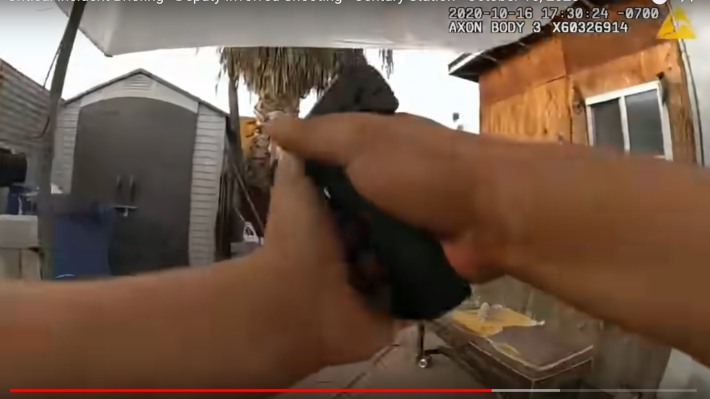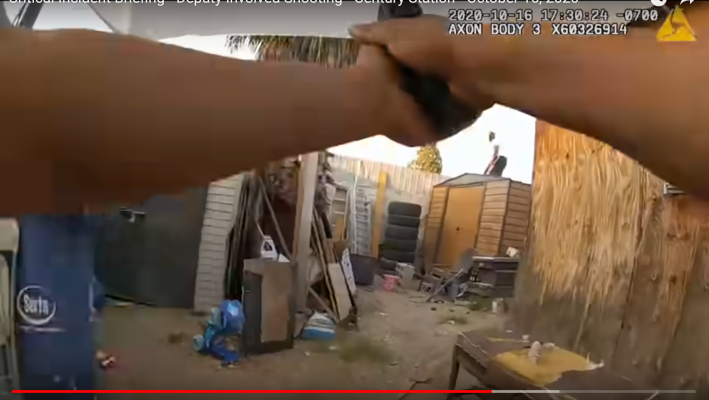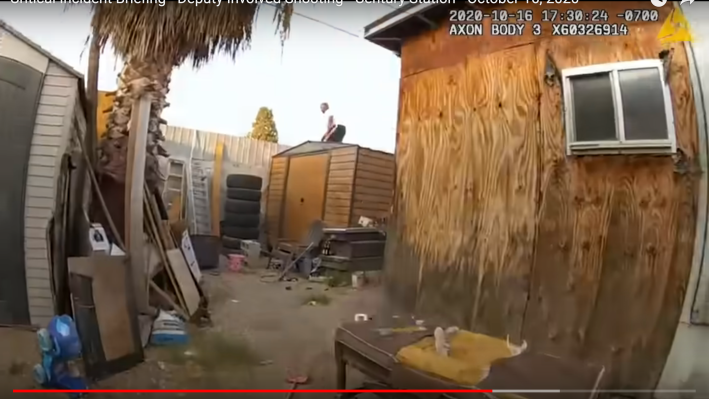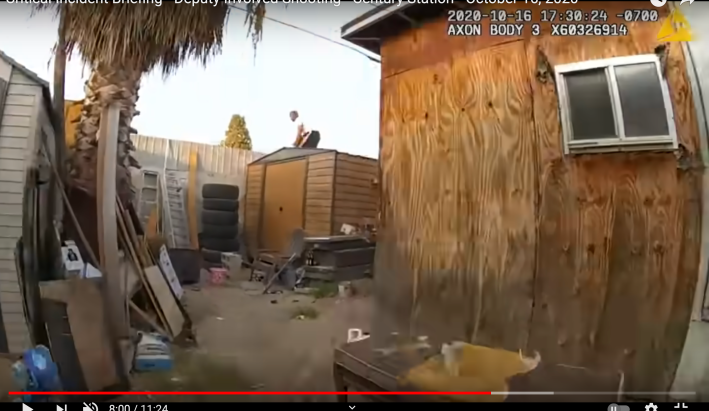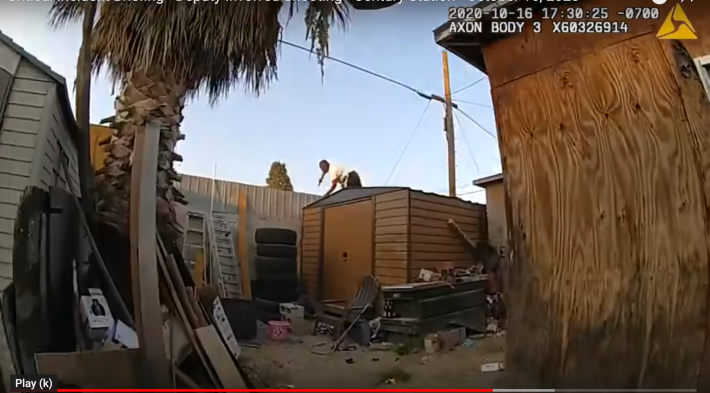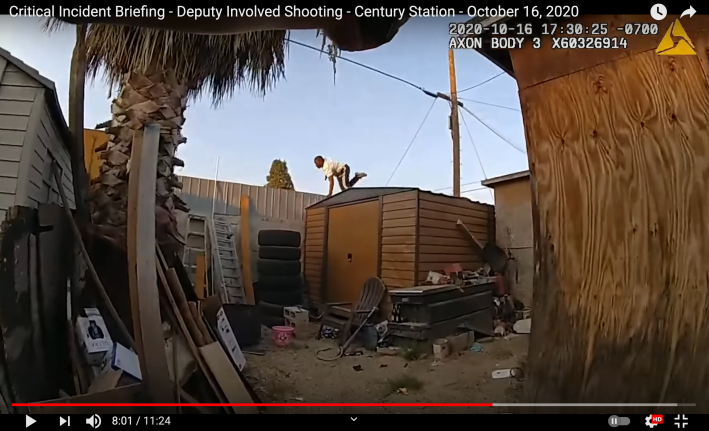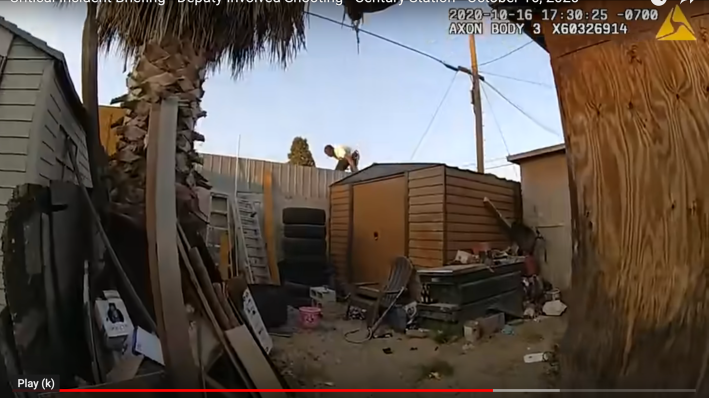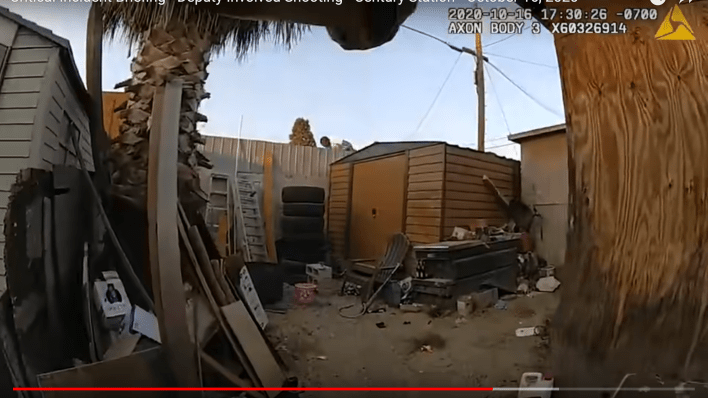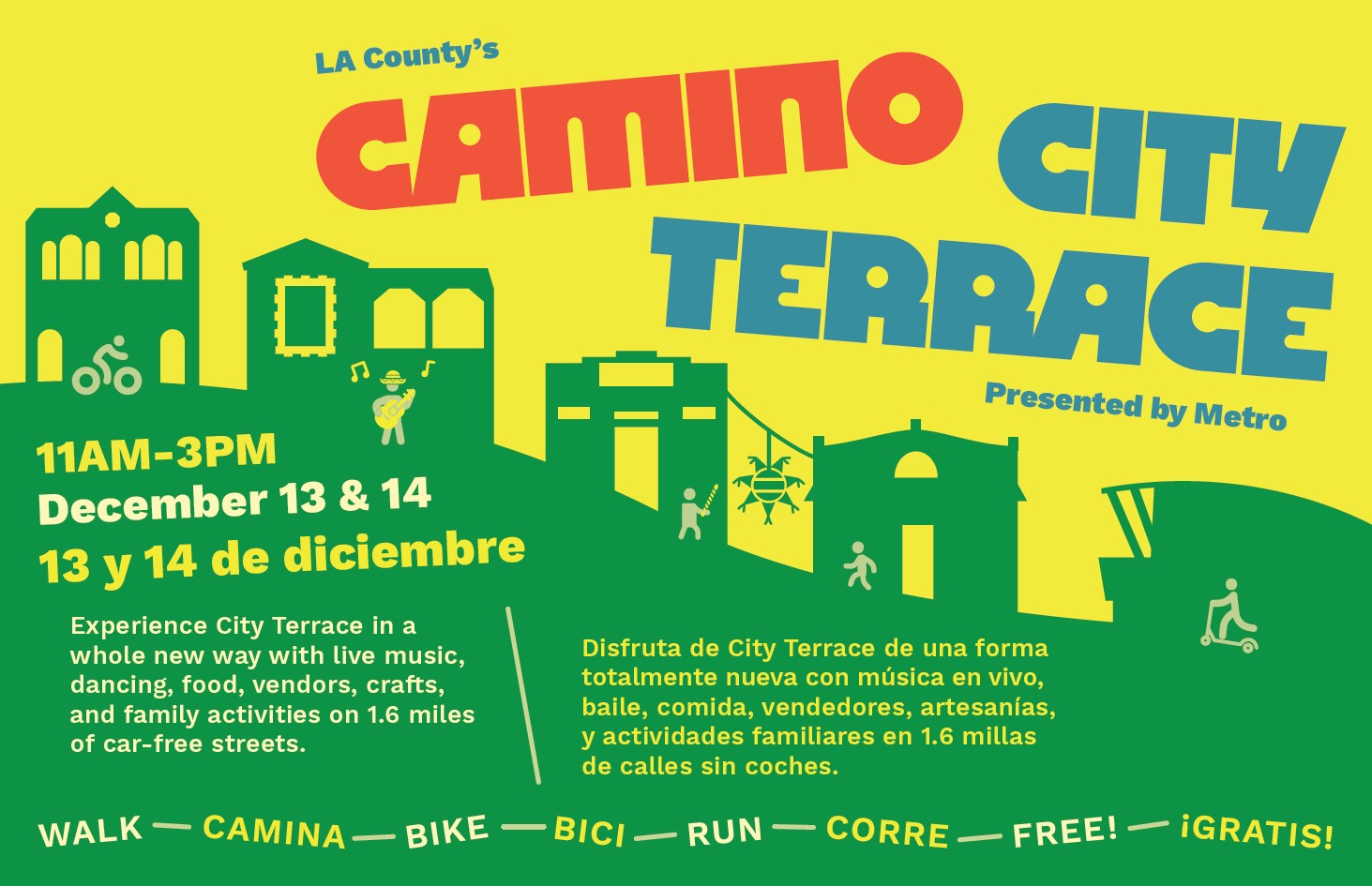The Los Angeles County Sheriff's Department (LASD) chose to keep the names of the deputies involved in the October 16 shooting of 25-year-old Fred Williams III in Willowbrook under wraps at the medical examiner's inquest last Thursday.
No explanation was given for the decision during the proceedings, but KPCC's Frank Stoltze reports that LASD has claimed it is motivated by a "credible threat of violence" against the deputy.
Such a claim is deeply suspect for a number of reasons, not least of which includes LASD's overt hostility to both the inquest process and transparency, more generally. But in practical terms, it meant that the inquest would yield little to nothing in the way of new information. Both the shooter and his partner pleaded the Fifth to protect themselves against self-incrimination and their statements and related case information were sealed from public view. Similarly, Detectives John O'Brien (seen below, in front of a Blue Lives Matter flag) and Christopher Dimmitt both effectively invoked the Fifth in spirit, claiming that answering any questions would compromise the integrity of the ongoing investigation into Williams' shooting by requiring them to disclose information from the sealed files. [Find my live tweets/recap of the inquest here.]
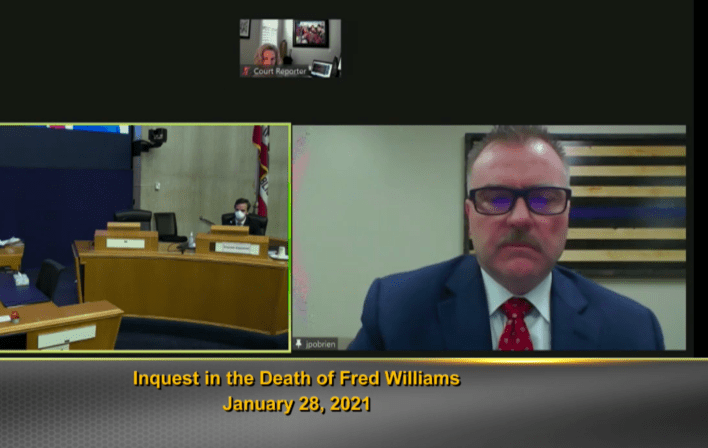
But the goal of the medical examiner's inquest was not to determine guilt, as retired Judge Candace Cooper reminded those tuning in Thursday. Instead, she said, it was to determine the manner and mode of death: natural causes, accident (which can include unintentional human conduct), suicide, or "death at the hands of another, other than by accident" (which does not address question of whether it was justified).
Her disclaimer seemed intended to preempt criticism of the process, given the disappointment that followed the November 30 inquest into the shooting death of 18-year-old Andrés Guardado. Guardado had been killed after deputies Miguel Vega and Chris Hernández said he looked at them, "produced" a handgun, and then ran down the driveway of the Gardena auto body shop he was working at. Vega briefly chased Guardado (seen here) before confronting him, ordering him to get on the ground, and then firing six times, hitting Guardado five times in the back.
The findings in that case - released just after 5 p.m. on January 15 (the Friday of a three-day weekend) to bury them - told people what they already knew. Namely, that the medical cause of Guardado's death was "multiple gunshot wounds" and that the manner of death was "by the hands of another person other than by accident."
Key issues casewatchers had at least hoped to see addressed - such as the significant discrepancy between deputy Miguel Vega's claims of how and why he shot Guardado and what the autopsy showed to be physically possible - had fallen outside of the scope of the inquiry.
...a sequence of events that completely contradicts the lawyer's claim that Guardado was on the ground reaching for the gun and that Vega shot him while he was already prone. https://t.co/0JCXmje2fO pic.twitter.com/KvL540wLRS
— sahra (@sahrasulaiman) January 16, 2021
So had larger questions about LASD's efforts to paint Guardado as dangerous (via a lengthy press briefing touching on illegal activity at the shop and unrelated shooting incidents) and about the heavy-handedness with which youth in the area are policed (especially in light of the kidnapping, taunting, terrorizing, and threatening of a young skateboarder that eventually led to both Vega and his partner Chris Hernández being relieved of duty).
All of which signaled to Williams' family and friends that the inquest would do little to assist them in their quest for answers or in holding LASD accountable.
Still the process can be said to have some value, both in keeping the names of the victims of police violence alive and in underscoring in a very public way just how difficult it is to exact any kind of transparency from law enforcement in these matters. Early on in the Guardado case, for example, Sheriff Alex Villanueva put a "security hold" on the autopsy, claiming its release would jeopardize the integrity of the investigation. Then, at the inquest last November, the detectives also hid behind the Fifth Amendment, despite the fact that, as investigators, there was no risk of self-incrimination. Meanwhile, the actual shooter - Vega - had elected to be out of the country during the first inquest L.A. was holding in over thirty years.
_______
If there was anything noteworthy about the Williams inquest last Thursday, it was that the Critical Incident Video LASD released, which included some of the deputy's body camera footage, was played during the proceedings to enter it into the record.
LASD only began rolling out body cams in earnest on October 1st. Williams was killed two weeks later, making this the first such incident captured by LASD on a body cam.
Given that LASD had essentially opted not to participate in the inquest, that footage and the narrative included in the video provided the only detailed version of events from the Sheriff's perspective that the public would hear that day.
That that version also went unchallenged may not be a problem with regard to the specific determination that Judge Cooper is tasked with making, but it is deeply problematic in light of LASD's claims about Williams' actions and intentions.
More generally, the extent to which law enforcement has treated "being armed," "being a threat," and "actively intending or seeking to do harm to officers" as interchangeable when it comes to Black and brown youth and men is what has allowed them to successfully argue time and again that an officer's fear for their life justified a shooting. This is especially true in cases where gang activity is prevalent (e.g. around Mona Park) and someone's gang affiliation or presence at a known gang hangout can be used as further support for the claim that the "suspect" intended to harm to an officer.
In Williams' case, LASD offers up what appears to be his mugshot, the prior felony convictions for burglary that (although nonviolent) prevented him from being able to own a gun, his current parole status, and images of the weapon he was carrying - all before the body cam footage of the deputy's encounter with him is ever played.
At one notable juncture, the video even zooms in on a screengrab of Williams - whom the narrator refers to as "William" throughout - holding the gun, which LASD has circled in red. As the viewer is left to take in this frozen image for a full fourteen seconds, the narrator intones, "As the deputy rounded the corner, he encountered William, gun in hand, on top of the shed, and a deputy-involved shooting occurred."
"Gun in hand" is meant to communicate that Williams posed an immediate and deadly threat.
Once the body cam footage is finally played at about 7:23 minutes in, however, we instead see what appears to be a man who was fleeing to avoid jail time for a gun charge - Williams had just gotten home after serving time on the burglary charge - and who carried the gun so it wouldn't drop out of his sweatpants as he jumped off a roof. We do not see someone who wanted to hurt either the family he ran past in the yard or the deputy.
Just two minutes earlier, Williams had been hanging out in the parking lot at Mona Park with friends and neighbors.

According to what witnesses told the L.A. Times, when LASD pulled up, people in the group assumed the deputies were there to harass them, prompting more than one person to take off. Williams, realizing that deputies had either had spotted the gun on him or were likely to engage him and find it, began running towards 122nd.
In his flight, he followed the trajectory of the yellow line seen below - exiting the parking lot, running down the driveway and into the back yard of a nearby home, climbing up on a shed, and jumping over a fence (at the "X") into the adjacent property. One deputy tracked him in the vehicle while the other chased him on foot (green arrow).
As he runs, it is clear that he is struggling to keep the gun from slipping out of his elastic waistband.
LASD used the screengrab with the red circle (top left, below) in the critical incident video to show that Williams was indeed armed - something observers had initially questioned - and point out where he was carrying the gun.
As Williams continues to run toward the back of the house, however, he appears to be struggling to keep it from slipping out of his waistband. He can be seen tugging at it as he comes down the driveway, and appears to try to shield it from the family as he shuffles past them.
He doesn't lift his hands from his waistband until he gets around the last corner, slows down, and moves to climb up on the shed.
Knowing Williams had a weapon, the deputy chasing him on foot appears to be concerned about being ambushed as he came around the corner. He is seen raising his weapon and can be heard shouting "Hands!" as he reaches the end of the first building and begins to head into the back yard.
Williams has already climbed up on the shed at that point, however, and does not come into the deputy's view until the deputy rounds another corner and gets to the back end of the property.
In the full sequence of twelve photos below, which represent about a second and a half's worth of time (timestamps 17:30:24 and 17:30:25), we see Williams has his back to the deputy from the very outset - when his left arm and shoulder first come into view (1st image; atop the shed, center) and the deputy is just beginning to raise his weapon again.
Williams remains angled away from the deputy throughout the entirety of the encounter, never even fully turning his head to focus on the deputy. Given that there was no camera on the shed, it is not clear when Williams took the gun out of his waistband, but it appears he did so as he prepared to jump from the roof, which is when it is first seen in his hand (the seventh image in the sequence below).
As the deputy raises his arms up and out of the camera view (below), we get a clearer look at Williams. We can see that he is wholly intent on figuring out a way to get over the fence, into the next yard, and away from that property (which is largely fenced in by the same high structure) while evading the deputy's partner (who was circling the block in the patrol vehicle to cut off Williams' escape).
The transition he has to make between the roof and the fence, the height of the fence itself, and the eight(ish)-foot drop to the ground appear to intimidate him; he doesn't just throw himself off the roof. Instead he edges closer to the fence, bends down, and reaches out to grab the fence with his left hand, seeking to vault himself over it.
He remains physically turned away from the deputy throughout this sequence. Although he appears to glance in the deputy's direction when he first hears him yell "Hey!", his focus is on moving away from the deputy.
It is at this moment - the moment that he reaches for the fence with his left hand and moves to vault himself over it - that we finally see the gun in his right hand (below; the LASD screengrab is included for reference).
It is also the moment the deputy claims the gun was pointed at him, telling dispatch afterwards, "He jumped the fence right before he pointed the 417 [firearm] at me." The coroner's investigator Lianna Darabedyan confirmed this is what she had heard from him as well, adding in that the deputy had told her Williams had also turned toward him when pointing his weapon at him.
But examining the footage in sequence, it is clear that Williams is looking down at the fence and the ground throughout and that we only see his right arm (and the gun) because of how he lifts it up to stabilize himself as he vaults. To launch himself over the fence and away from the deputy, he has to grip the edge of a thin sheet of (what appears to be) metal and put his full weight on his left arm (seen in the second frame).
To have pointed the weapon at the deputy at this moment, he would have had to swing his right arm across his body in the opposite direction to the one he is headed in while in midair (in the third and fourth frames below). Doing so would have thrown him off balance, at the very least, and likely caused him to twist in the air. Aiming at the deputy would also have required him to at least turn his head in that direction, and probably his torso, as well - neither of which happens here.
Instead, he vaults, left hand still supporting his weight on the fence and right arm still out for balance. The deputy shouts at him to put his hands up as Williams begins to drop out of view. The gun is still all the way over on Williams' far side (it can be seen sticking out from behind his right thigh in the penultimate frame).
The deputy fires eight times in quick succession, hitting Williams once in his upper left back, perforating his left lung and his aorta.
Williams later died at the scene.
_______
Once Judge Cooper has finished reviewing the testimony and the sealed statements from the deputies involved in the shooting, she will likely issue the same findings she did in the Guardado case. And given that she saw no need to push LASD on its abuse of the Fifth Amendment in that case, it is unlikely she will try to hold LASD accountable for its intransigence here, either.
Meanwhile, the Sheriff's internal investigation is ongoing. When completed, it will be turned over to the Justice System Integrity Division of the District Attorney's Office, which will determine whether the force used was within the law. Then the case will go back to the Internal Affairs Bureau, which will complete an administrative investigation of the incident before passing it on to LASD's Executive Force Review Committee. That committee will evaluate the deputies' performance and determine whether the tactics and use of force were within policy.
While officer-involved shootings were almost always found to be within policy during former D.A. Jackie Lacey's tenure, officers' tactics were occasionally found wanting by either LASD or LAPD. When that happened, as it did in the case of Keith Bursey, who was shot in the back by LAPD officer Charles Kumlander in 2016 during an investigative stop at Brynhurst and Slauson, the officers in question might be recommended for tactical debrief and extensive retraining, as Kumlander and his partner were. And like Kumlander and his partner, they rarely face other consequences for an "in policy" killing, even if the tactical lapses played a role in how a victim ended up dead.
The election of George Gascón to D.A. this past November and his promise to revisit some of these cases offered the families of the victims of police violence hope that there might finally be some semblance of justice for their loved ones. Or, at the very least, some accountability.
But what they also want is some reassurance that these processes will work to prevent other families from experiencing this kind of loss going forward. In our next story in this series, we will engage that question by way of unpacking some of the more complex cases, like Bursey's, to see what they tell us about the way lower-income Black and brown communities are policed.
In the meanwhile, find the critical incident video from Fred Williams' case here. See the live-tweet/recap thread I did on the inquest here. See the live-tweet/recap thread of the Andrés Guardado inquest here and a discussion of the inquest findings here. The findings from the Guardado inquest can be found here or here.
Find me on twitter, @sahrasulaiman, or email me at sahra@streetsblog.org.
_______
Related stories
- September, 2020 - A deconstruction of the LASD claims regarding the August 31 killing of 29-year-old Dijon Kizzee in Westmont: Video Provided by Sheriffs Directly Contradicts Their Own Account of Killing of Dijon Kizzee
- July, 2020 - Jermaine Welch was passing through Broadway and 86th Pl. on June 3 when his car was sprayed with gunfire. Instead of handing him back his belongings when he went to retrieve them, LAPD handed him a warrant for his phone. They were trying to implicate him in his own attempted murder while remaining tight-lipped about how/why an officer fired into the crowd at that site that night: Bystander Shot Six Times During Officer-Involved Shooting Left Homeless, Struggling to Recover while LAPD Treats Him as Suspect
- June, 2020 - A deconstruction of the unprovoked beating of an unarmed, unhoused man in Boyle Heights by the LAPD officer sent to evict him for trespassing on a vacant lot. In public statements, LAPD said they were concerned about the incident, which was caught on camera by a neighbor. Then, just before the body cam footage was released, LAPD fed NBC4's investigative team false information suggesting the victim had been armed and trying to hurt the officer. How Beating of Unhoused Boyle Heights Man Exposes Woeful Inadequacy of LAPD Reform Proposals
- Early 2018 - An LAPD officer patrolling the Red Line dragged a teen girl off the train after she didn't put her feet down off the seat fast enough. She was eventually detained by enough officers to field a football team. Teen Hauled Off Metro Train, Cuffed for Putting Her Feet Up. The public sentiment was largely in favor of that outcome, and had little patience for thinking about why it mattered that an officer immediately resorted to physical coercion in the lowest-stakes case scenario. “Burn the Witch!”: Public Enthusiasm for Dragging Rude Youth from Trains Highlights Gap in Metro’s Equity Platform
Other stories on the intersection of repressive policing, disenfranchisement, and trauma in the public space
The impact of trauma:
- As L.A. Ramps up Efforts to Get People off the Streets, a Young Man Struggles to Stay Housed
- Death and All His Friends Cast Long Shadows when they Make Regular Appearances in the Public Space
- To Be or Not to Be a Gang-Banger: Is that Really the Question?
- What Does the “Failure” of the Ban on Fast-Food Restaurants in South L.A. to Curb Obesity Really Tell Us?
How under/overpolicing in a community can fuel violence and force youth to fend for themselves:
- The history of South Central via the story of Nipsey Hussle
- "I Can't Go Everywhere I Thought I Could Go": When Black and Brown Cyclists Need Safety from More than Traffic
- “Invest in Us!” say South L.A. Youth in Response to Questions about How to Curb Violence at Town Hall with Garcetti
- It’s a Small World: How Gang Activity Impacts the Livability of Streets (part 1); Are You Ready to Rumble?: Street Fights Take More Violent Turns (part 2); Listening to the Streets in Order to Make Them More Livable: Part III in a Series (part 3)
- South Central Youth Assess Stasis and Change 25 years after the 1992 Unrest
Racial Profiling:
- A Tale of Two Communities: New Security Measures at USC Intensify Profiling of Lower-Income Youth of Color (part 1); A Tale of Two Communities, Part II: LAPD Finds it Stirred Up Hornets’ Nest by Profiling USC Students of Color (part 2)
- Gardena PD Ticket, Harass United Riders of South Los Angeles for Taking Lane while the Case of the Hit-and-Run Victim They Were Honoring Remains Unsolved
- “You Don’t Belong Here:” Sheriffs Profile Reporter
- Are You Supposed to be Here?: Officer Harasses Black Cyclists during MLK Day Parade
- Filed Under: Ugly Things You Find on the Interwebs (an FB page claiming black people steal bikes)
- Days of Dialogue Opens Conversation on Police-Community Relations in South L.A., Gets an Earful
- Family of Man Crushed by Train During Altercation with Police over Fare Seeks Answers, Justice
- Video of Moments Before Man Crushed by Blue Line Train Raises More Questions for Family in Mourning
Incorporating these issues into planning processes:
- Webinar on Policing and Mobility Underscores Struggle of Urban Planning to Center Justice (2018)
- Ancestors v. Polka Dots: Some Thoughts on Approaches to “Place-Making” (2017)
- Equity 101: Bikes v. Bodies on Bikes (2016)
- Man is Shot and Killed by the Officers He Called to Help Search for Stolen Bike. Is it a Livable Streets Issue? (2015)
- Election Reflections: “Law-and-Order,” the Resilience of White Supremacy, and You (2016)
- A Case for the Incorporation of Questions of Access Into Planning for Complete Streets (2013)
Other readings on the legacy of redlining:
- The Color of Law & Residential Segregation: A “Walking Toward Justice” Webinar
- Destination Crenshaw and the Rise of We-Built-this-Place-Making
- Art, the Crenshaw/LAX Line, and the Stories We (Don’t) Tell at Train Stations
- Baldwin Hills Crenshaw Plaza Offers Window into History of Redevelopment, Legacy of White Flight
- As Vermont/Manchester Transportation School Moves Forward, Community Reckons with Past, Wrestles with Form Change Should Take
- Jobs or Housing? Historic South Central Residents Decry Feeling Asked to Choose by Billion Dollar Reef Project
- What Constitutes Good Development? Luxury REEF Project Approved over South Central Residents’ Fears of Displacement
- Measure S and the Terrible, Horrible, No Good, Very Bad Status Quo
- Exploring the Legacy of Redlining via a New Documentary about Boyle Heights
